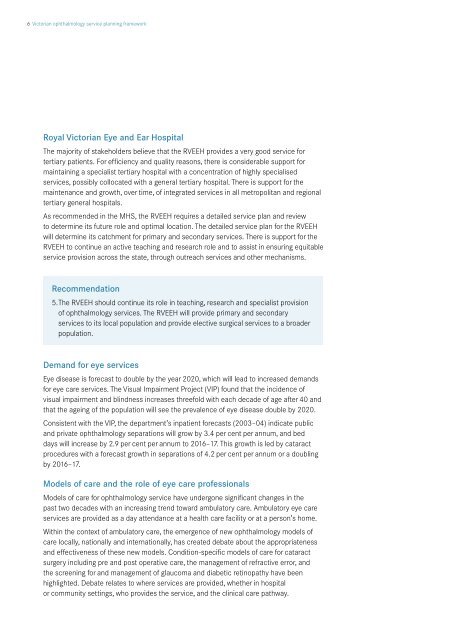Victorian ophthalmology service planning framework
Victorian ophthalmology service planning framework
Victorian ophthalmology service planning framework
Create successful ePaper yourself
Turn your PDF publications into a flip-book with our unique Google optimized e-Paper software.
6 <strong>Victorian</strong> <strong>ophthalmology</strong> <strong>service</strong> <strong>planning</strong> <strong>framework</strong><br />
Royal <strong>Victorian</strong> Eye and Ear Hospital<br />
The majority of stakeholders believe that the RVEEH provides a very good <strong>service</strong> for<br />
tertiary patients. For efficiency and quality reasons, there is considerable support for<br />
maintaining a specialist tertiary hospital with a concentration of highly specialised<br />
<strong>service</strong>s, possibly collocated with a general tertiary hospital. There is support for the<br />
maintenance and growth, over time, of integrated <strong>service</strong>s in all metropolitan and regional<br />
tertiary general hospitals.<br />
As recommended in the MHS, the RVEEH requires a detailed <strong>service</strong> plan and review<br />
to determine its future role and optimal location. The detailed <strong>service</strong> plan for the RVEEH<br />
will determine its catchment for primary and secondary <strong>service</strong>s. There is support for the<br />
RVEEH to continue an active teaching and research role and to assist in ensuring equitable<br />
<strong>service</strong> provision across the state, through outreach <strong>service</strong>s and other mechanisms.<br />
Recommendation<br />
5. The RVEEH should continue its role in teaching, research and specialist provision<br />
of <strong>ophthalmology</strong> <strong>service</strong>s. The RVEEH will provide primary and secondary<br />
<strong>service</strong>s to its local population and provide elective surgical <strong>service</strong>s to a broader<br />
population.<br />
Demand for eye <strong>service</strong>s<br />
Eye disease is forecast to double by the year 2020, which will lead to increased demands<br />
for eye care <strong>service</strong>s. The Visual Impairment Project (VIP) found that the incidence of<br />
visual impairment and blindness increases threefold with each decade of age after 40 and<br />
that the ageing of the population will see the prevalence of eye disease double by 2020.<br />
Consistent with the VIP, the department’s inpatient forecasts (2003–04) indicate public<br />
and private <strong>ophthalmology</strong> separations will grow by 3.4 per cent per annum, and bed<br />
days will increase by 2.9 per cent per annum to 2016–17. This growth is led by cataract<br />
procedures with a forecast growth in separations of 4.2 per cent per annum or a doubling<br />
by 2016–17.<br />
Models of care and the role of eye care professionals<br />
Models of care for <strong>ophthalmology</strong> <strong>service</strong> have undergone significant changes in the<br />
past two decades with an increasing trend toward ambulatory care. Ambulatory eye care<br />
<strong>service</strong>s are provided as a day attendance at a health care facility or at a person’s home.<br />
Within the context of ambulatory care, the emergence of new <strong>ophthalmology</strong> models of<br />
care locally, nationally and internationally, has created debate about the appropriateness<br />
and effectiveness of these new models. Condition-specific models of care for cataract<br />
surgery including pre and post operative care, the management of refractive error, and<br />
the screening for and management of glaucoma and diabetic retinopathy have been<br />
highlighted. Debate relates to where <strong>service</strong>s are provided, whether in hospital<br />
or community settings, who provides the <strong>service</strong>, and the clinical care pathway.

















